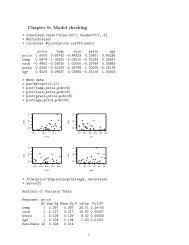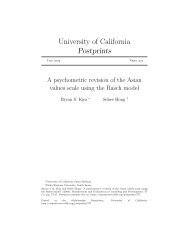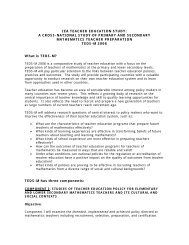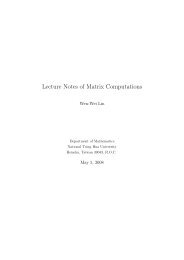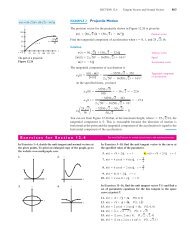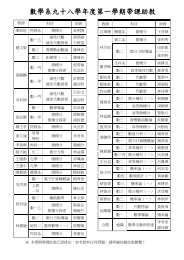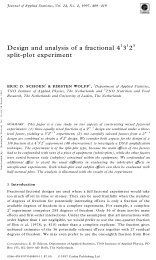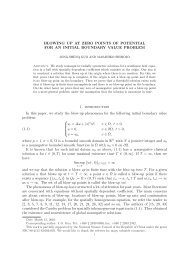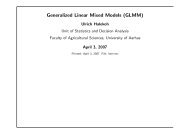BVP of ODE
BVP of ODE
BVP of ODE
Create successful ePaper yourself
Turn your PDF publications into a flip-book with our unique Google optimized e-Paper software.
<strong>BVP</strong> <strong>of</strong> <strong>ODE</strong> 1Boundary-Value Problems for OrdinaryDifferential EquationsNTNUTsung-Min HwangDecember 20, 2003Department <strong>of</strong> Mathematics – NTNU Tsung-Min Hwang December 20, 2003
<strong>BVP</strong> <strong>of</strong> <strong>ODE</strong> 21 – Mathematical Theories . . . . . . . . . . . . . . . . . . . . . . . . . . . . . 42 – Finite Difference Method For Linear Problems . . . . . . . . . . . . . . . . . 152.1 – The Finite Difference Formulation . . . . . . . . . . . . . . . . . . . . . . 152.2 – Convergence Analysis . . . . . . . . . . . . . . . . . . . . . . . . . . . 193 – Shooting Methods . . . . . . . . . . . . . . . . . . . . . . . . . . . . . . . 22Department <strong>of</strong> Mathematics – NTNU Tsung-Min Hwang December 20, 2003
<strong>BVP</strong> <strong>of</strong> <strong>ODE</strong> 3The two-point boundary-value problems (<strong>BVP</strong>) considered in this chapter involve asecond-order differential equation together with boundary condition in the following form:⎧⎨y ′′ = f(x, y, y ′ )⎩y(a) = α, y(b) = β(1)Department <strong>of</strong> Mathematics – NTNU Tsung-Min Hwang December 20, 2003
<strong>BVP</strong> <strong>of</strong> <strong>ODE</strong> 3The two-point boundary-value problems (<strong>BVP</strong>) considered in this chapter involve asecond-order differential equation together with boundary condition in the following form:⎧⎨y ′′ = f(x, y, y ′ )⎩y(a) = α, y(b) = β(1)The numerical procedures for finding approximate solutions to the initial-value problems cannot be adapted to the solution <strong>of</strong> this problem since the specification <strong>of</strong> conditions involvetwo different points, x = a and x = b.Department <strong>of</strong> Mathematics – NTNU Tsung-Min Hwang December 20, 2003
<strong>BVP</strong> <strong>of</strong> <strong>ODE</strong> 3The two-point boundary-value problems (<strong>BVP</strong>) considered in this chapter involve asecond-order differential equation together with boundary condition in the following form:⎧⎨y ′′ = f(x, y, y ′ )⎩y(a) = α, y(b) = β(1)The numerical procedures for finding approximate solutions to the initial-value problems cannot be adapted to the solution <strong>of</strong> this problem since the specification <strong>of</strong> conditions involvetwo different points, x = a and x = b. New techniques are introduced in this chapter forhandling problems (1) in which the conditions imposed are <strong>of</strong> a boundary-value rather thanan initial-value type.Department <strong>of</strong> Mathematics – NTNU Tsung-Min Hwang December 20, 2003
<strong>BVP</strong> <strong>of</strong> <strong>ODE</strong> 41 – Mathematical TheoriesBefore considering numerical methods, a few mathematical theories about the two-pointboundary-value problem (1), such as the existence and uniqueness <strong>of</strong> solution, shall bediscussed in this section.Theorem 1 Suppose that f in (1) is continuous on the setand that ∂f∂y1.D = {(x, y, y ′ )|a ≤ x ≤ b, −∞ < y < ∞, −∞ < y ′ < ∞} ,∂fand are also continuous on D. If∂y′∂f∂y (x, y, y′ ) > 0 for all (x, y, y ′ ) ∈ D, and∂f∣∂y ′ (x, y, y′ )∣ ≤ M , ∀ (x, y, y′ ) ∈ D,2. a constant M exists, withthen (1) has a unique solution.Department <strong>of</strong> Mathematics – NTNU Tsung-Min Hwang December 20, 2003
<strong>BVP</strong> <strong>of</strong> <strong>ODE</strong> 5When the function f(x, y, y ′ ) has the special formf(x, y, y ′ ) = p(x)y ′ + q(x)y + r(x),the differential equation become a so-called linear problem. The previous theorem can besimplified for this case.Corollary 1 If the linear two-point boundary-value problemsatisfies⎧⎨y ′′ = p(x)y ′ + q(x)y + r(x)⎩y(a) = α, y(b) = β1. p(x), q(x), and r(x) are continuous on [a, b], and2. q(x) > 0 on [a, b],then the problem has a unique solution.Department <strong>of</strong> Mathematics – NTNU Tsung-Min Hwang December 20, 2003
<strong>BVP</strong> <strong>of</strong> <strong>ODE</strong> 6Many theories and application models consider the boundary-value problem in a specialform as follows.⎧⎨y ′′ = f(x, y)⎩y(0) = 0, y(1) = 0We will show that this simple form can be derived from the original problem by simpletechniques such as changes <strong>of</strong> variables and linear transformation. To do this, we begin bychanging the variable. Suppose that the original problem is⎧⎨y ′′ = f(x, y)⎩y(a) = α,y(b) = βwhere y = y(x). Now let λ = b − a and define a new variablet = x − ab − a = 1 (x − a).λ(2)Department <strong>of</strong> Mathematics – NTNU Tsung-Min Hwang December 20, 2003
<strong>BVP</strong> <strong>of</strong> <strong>ODE</strong> 7That is, x = a + λt. Notice that t = 0 corresponds to x = a, and t = 1 corresponds tox = b. Then we definewith λ = b − a. This givesz(t) = y(a + λt) = y(x)z ′ (t) = d dt z(t) = d dt y(a + λt) = [ ddx y(x) ] [ ddt (a + λt) ]and, analogously,= λy ′ (x)z ′′ (t) = d dt z′ (t) = λ 2 y ′′ (x) = λ 2 f(x, y(x)) = λ 2 f(a + λt, z(t)).Likewise the boundary conditions are changed toz(0) = y(a) = α and z(1) = y(b) = β.Department <strong>of</strong> Mathematics – NTNU Tsung-Min Hwang December 20, 2003
<strong>BVP</strong> <strong>of</strong> <strong>ODE</strong> 9and the original equation is reduced toλ 2 f(a + λt, z) = 9 [ sin(1 + 3t)z + z 2] ,⎧⎨z ′′ (t) = 9 sin((1 + 3t)z) + 9z 2⎩z(0) = 3, z(1) = 7To reduce a two-point boundary-value problemto a homogeneous system, let⎧⎨z ′′ (t) = g(t, z)⎩z(0) = α, z(1) = βu(t) = z(t) − [α + (β − α)t]then u ′′ (t) = z ′′ (t), andu(0) = z(0) − α = 0 and u(1) = z(1) − β = 0Department <strong>of</strong> Mathematics – NTNU Tsung-Min Hwang December 20, 2003
<strong>BVP</strong> <strong>of</strong> <strong>ODE</strong> 10Moreover,g(t, z) = g(t, u + α + (β − α)t) ≡ h(t, u).The system is now transformed intoExample 2 Reduce the system⎧⎨u ′′ (t) = h(t, u)⎩u(0) = 0, u(1) = 0⎧⎨z ′′ = [5z − 10t + 35 + sin(3z − 6t + 21)]e t⎩z(0) = −7, z(1) = −5to a homogeneous problem by linear transformation technique.Solution: Letu(t) = z(t) − [−7 + (−5 + 7)t] = z(t) − 2t + 7.Department <strong>of</strong> Mathematics – NTNU Tsung-Min Hwang December 20, 2003
<strong>BVP</strong> <strong>of</strong> <strong>ODE</strong> 11Then z(t) = u(t) + 2t − 7, andu ′′ = z ′′ = [5z − 10t + 35 + sin(3z − 6t + 21)]e t= [5(u + 2t − 7) − 10t + 35 + sin(3(u + 2t − 7) − 6t + 21)]e t= [5u + sin(3u)]e tThe system is transformed to⎧⎨u ′′ (t) = [5u + sin(3u)]e t⎩u(0) = u(1) = 0Example 3 Reduce the following two-point boundary-value problem⎧⎨y ′′ = y 2 + 3 − x 2 + xy⎩y(3) = 7, y(5) = 9to a homogeneous system.Department <strong>of</strong> Mathematics – NTNU Tsung-Min Hwang December 20, 2003
<strong>BVP</strong> <strong>of</strong> <strong>ODE</strong> 12Solution: In the original system, a = 3, b = 5, α = 7, β = 9. Let λ = b − a = 2 anddefine a new variablet = 1 (x − 3) =⇒ x = 2t + 3.2Let the function z(t) = y(x) = y(2t + 3). Thenz ′′ (t) = λ 2 y ′′ (2t + 3) = λ 2 f(2t + 3, u)The original problem is first transformed intoNext let= 4[z 2 + 3 − (2t + 3) 2 + (2t + 3)z]= 4[z 2 + 3z + 2tz − 4t 2 − 12t − 6]⎧⎨z ′′ (t) = 4[z 2 + 3z + 2tz − 4t 2 − 12t − 6]⎩z(0) = 7, z(1) = 9u(t) = z(t) − [7 + 2t], or equivalently, z(t) = u(t) + 2t + 7.Department <strong>of</strong> Mathematics – NTNU Tsung-Min Hwang December 20, 2003
<strong>BVP</strong> <strong>of</strong> <strong>ODE</strong> 13Thenu ′′ (t) = 4[(z + 2t + 7) 2 + 3(u + 2t + 7) + 2t(u + 2t + 7) − 4t 2 − 12t − 6]= 4[u 2 + 6tu + 17u + 4t 2 + 36t + 64].The original problem is transformed into the following homogeneous system⎧⎨u ′′ (t) = 4[u 2 + 6tu + 17u + 4t 2 + 36t + 64]⎩u(0) = u(1) = 0Theorem 2 The boundary-value problemhas a unique solution if ∂f∂y0 ≤ x ≤ 1 and −∞ < y < ∞.⎧⎨y ′′ = f(x, y)⎩y(0) = 0, y(1) = 0is continuous, non-negative, and bounded in the stripDepartment <strong>of</strong> Mathematics – NTNU Tsung-Min Hwang December 20, 2003
<strong>BVP</strong> <strong>of</strong> <strong>ODE</strong> 14Theorem 3 If f is a continuous function <strong>of</strong> (s, t) in the domain 0 ≤ s ≤ 1 and−∞ < t < ∞ such that|f(s, t 1 ) − f(s, t 2 )| ≤ K|t 1 − t 2 |, (K < 8).Then the boundary-value problemhas a unique solution in C[0, 1].⎧⎨y ′′ = f(x, y)⎩y(0) = 0, y(1) = 0Department <strong>of</strong> Mathematics – NTNU Tsung-Min Hwang December 20, 2003
<strong>BVP</strong> <strong>of</strong> <strong>ODE</strong> 152 – Finite Difference Method For Linear ProblemsWe consider finite difference method for solving the linear two-point boundary-value problem<strong>of</strong> the form⎧⎨ y ′′ = p(x)y ′ + q(x)y + r(x)⎩y(a) = α, y(b) = β.(4)Department <strong>of</strong> Mathematics – NTNU Tsung-Min Hwang December 20, 2003
<strong>BVP</strong> <strong>of</strong> <strong>ODE</strong> 152 – Finite Difference Method For Linear ProblemsWe consider finite difference method for solving the linear two-point boundary-value problem<strong>of</strong> the form⎧⎨ y ′′ = p(x)y ′ + q(x)y + r(x)⎩y(a) = α, y(b) = β.Methods involving finite differences for solving boundary-value problems replace each <strong>of</strong> thederivatives in the differential equation by an appropriate difference-quotient approximation.(4)Department <strong>of</strong> Mathematics – NTNU Tsung-Min Hwang December 20, 2003
<strong>BVP</strong> <strong>of</strong> <strong>ODE</strong> 152 – Finite Difference Method For Linear ProblemsWe consider finite difference method for solving the linear two-point boundary-value problem<strong>of</strong> the form⎧⎨ y ′′ = p(x)y ′ + q(x)y + r(x)⎩y(a) = α, y(b) = β.(4)Methods involving finite differences for solving boundary-value problems replace each <strong>of</strong> thederivatives in the differential equation by an appropriate difference-quotient approximation.2.1 – The Finite Difference FormulationDepartment <strong>of</strong> Mathematics – NTNU Tsung-Min Hwang December 20, 2003
<strong>BVP</strong> <strong>of</strong> <strong>ODE</strong> 152 – Finite Difference Method For Linear ProblemsWe consider finite difference method for solving the linear two-point boundary-value problem<strong>of</strong> the form⎧⎨ y ′′ = p(x)y ′ + q(x)y + r(x)⎩y(a) = α, y(b) = β.(4)Methods involving finite differences for solving boundary-value problems replace each <strong>of</strong> thederivatives in the differential equation by an appropriate difference-quotient approximation.2.1 – The Finite Difference FormulationFirst, partition the interval [a, b] into n equally-spaced subintervals by pointsa = x 0 < x 1 < . . . < x n < x n = b.Department <strong>of</strong> Mathematics – NTNU Tsung-Min Hwang December 20, 2003
<strong>BVP</strong> <strong>of</strong> <strong>ODE</strong> 152 – Finite Difference Method For Linear ProblemsWe consider finite difference method for solving the linear two-point boundary-value problem<strong>of</strong> the form⎧⎨ y ′′ = p(x)y ′ + q(x)y + r(x)⎩y(a) = α, y(b) = β.(4)Methods involving finite differences for solving boundary-value problems replace each <strong>of</strong> thederivatives in the differential equation by an appropriate difference-quotient approximation.2.1 – The Finite Difference FormulationFirst, partition the interval [a, b] into n equally-spaced subintervals by pointsa = x 0 < x 1 < . . . < x n < x n = b. Each mesh point x i can be computed byx i = a + i ∗ h,i = 0, 1, . . . , n, with h = b − anwhere h is called the mesh size.Department <strong>of</strong> Mathematics – NTNU Tsung-Min Hwang December 20, 2003
<strong>BVP</strong> <strong>of</strong> <strong>ODE</strong> 16At the interior mesh points, x i , for i = 1, 2, . . . , n − 1, the differential equation to beapproximated satisfiesy ′′ (x i ) = p(x i )y ′ (x i ) + q(x i )y(x i ) + r(x i ). (5)Department <strong>of</strong> Mathematics – NTNU Tsung-Min Hwang December 20, 2003
<strong>BVP</strong> <strong>of</strong> <strong>ODE</strong> 16At the interior mesh points, x i , for i = 1, 2, . . . , n − 1, the differential equation to beapproximated satisfiesThe central finite difference formulaey ′′ (x i ) = p(x i )y ′ (x i ) + q(x i )y(x i ) + r(x i ). (5)y ′ (x i ) = y(x i+1) − y(x i−1 )2h− h26 y(3) (η i ), (6)for some η i in the interval (x i−1 , x i+1 ),Department <strong>of</strong> Mathematics – NTNU Tsung-Min Hwang December 20, 2003
<strong>BVP</strong> <strong>of</strong> <strong>ODE</strong> 16At the interior mesh points, x i , for i = 1, 2, . . . , n − 1, the differential equation to beapproximated satisfiesThe central finite difference formulaey ′′ (x i ) = p(x i )y ′ (x i ) + q(x i )y(x i ) + r(x i ). (5)y ′ (x i ) = y(x i+1) − y(x i−1 )2h− h26 y(3) (η i ), (6)for some η i in the interval (x i−1 , x i+1 ), andy ′′ (x i ) = y(x i+1) − 2y(x i ) + y(x i−1 )h 2− h212 y(4) (ξ i ), (7)for some ξ i in the interval (x i−1 , x i+1 ), can be derived from Taylor’s theorem byexpanding y about x i .Department <strong>of</strong> Mathematics – NTNU Tsung-Min Hwang December 20, 2003
<strong>BVP</strong> <strong>of</strong> <strong>ODE</strong> 16At the interior mesh points, x i , for i = 1, 2, . . . , n − 1, the differential equation to beapproximated satisfiesThe central finite difference formulaey ′′ (x i ) = p(x i )y ′ (x i ) + q(x i )y(x i ) + r(x i ). (5)y ′ (x i ) = y(x i+1) − y(x i−1 )2h− h26 y(3) (η i ), (6)for some η i in the interval (x i−1 , x i+1 ), andy ′′ (x i ) = y(x i+1) − 2y(x i ) + y(x i−1 )h 2− h212 y(4) (ξ i ), (7)for some ξ i in the interval (x i−1 , x i+1 ), can be derived from Taylor’s theorem byexpanding y about x i .Let u i denote the approximate value <strong>of</strong> y i = y(x i ).Department <strong>of</strong> Mathematics – NTNU Tsung-Min Hwang December 20, 2003
<strong>BVP</strong> <strong>of</strong> <strong>ODE</strong> 16At the interior mesh points, x i , for i = 1, 2, . . . , n − 1, the differential equation to beapproximated satisfiesThe central finite difference formulaey ′′ (x i ) = p(x i )y ′ (x i ) + q(x i )y(x i ) + r(x i ). (5)y ′ (x i ) = y(x i+1) − y(x i−1 )2h− h26 y(3) (η i ), (6)for some η i in the interval (x i−1 , x i+1 ), andy ′′ (x i ) = y(x i+1) − 2y(x i ) + y(x i−1 )h 2− h212 y(4) (ξ i ), (7)for some ξ i in the interval (x i−1 , x i+1 ), can be derived from Taylor’s theorem byexpanding y about x i .Let u i denote the approximate value <strong>of</strong> y i = y(x i ). If y ∈ C 4 [a, b], then a finite differencemethod with truncation error <strong>of</strong> order O(h 2 ) can be obtained by using the approximationsDepartment <strong>of</strong> Mathematics – NTNU Tsung-Min Hwang December 20, 2003
<strong>BVP</strong> <strong>of</strong> <strong>ODE</strong> 17y ′ (x i ) ≈ u i+1 − u i−12hfor y ′ (x i ) and y ′′ (x i ), respectively.andy ′′ (x i ) ≈ u i+1 − 2u i + u i−1h 2Department <strong>of</strong> Mathematics – NTNU Tsung-Min Hwang December 20, 2003
<strong>BVP</strong> <strong>of</strong> <strong>ODE</strong> 17y ′ (x i ) ≈ u i+1 − u i−12handfor y ′ (x i ) and y ′′ (x i ), respectively. Furthermore, lety ′′ (x i ) ≈ u i+1 − 2u i + u i−1h 2p i = p(x i ), q i = q(x i ), r i = r(x i ).Department <strong>of</strong> Mathematics – NTNU Tsung-Min Hwang December 20, 2003
<strong>BVP</strong> <strong>of</strong> <strong>ODE</strong> 17y ′ (x i ) ≈ u i+1 − u i−12handfor y ′ (x i ) and y ′′ (x i ), respectively. Furthermore, letThe discrete version <strong>of</strong> equation (4) is thenu i+1 − 2u i + u i−1h 2y ′′ (x i ) ≈ u i+1 − 2u i + u i−1h 2p i = p(x i ), q i = q(x i ), r i = r(x i ).= p iu i+1 − u i−12htogether with boundary conditions u 0 = α and u n = β.+ q i u i + r i , i = 1, 2, . . . , n − 1, (8)Department <strong>of</strong> Mathematics – NTNU Tsung-Min Hwang December 20, 2003
<strong>BVP</strong> <strong>of</strong> <strong>ODE</strong> 17y ′ (x i ) ≈ u i+1 − u i−12handfor y ′ (x i ) and y ′′ (x i ), respectively. Furthermore, letThe discrete version <strong>of</strong> equation (4) is thenu i+1 − 2u i + u i−1h 2y ′′ (x i ) ≈ u i+1 − 2u i + u i−1h 2p i = p(x i ), q i = q(x i ), r i = r(x i ).= p iu i+1 − u i−12h+ q i u i + r i , i = 1, 2, . . . , n − 1, (8)together with boundary conditions u 0 = α and u n = β. Equation (8) can be written in theform (1 + h )2 p i u i−1 − ( 2 + h 2 )q i ui +for i = 1, 2, . . . , n − 1.(1 − h )2 p i u i+1 = h 2 r i , (9)Department <strong>of</strong> Mathematics – NTNU Tsung-Min Hwang December 20, 2003
<strong>BVP</strong> <strong>of</strong> <strong>ODE</strong> 17y ′ (x i ) ≈ u i+1 − u i−12handfor y ′ (x i ) and y ′′ (x i ), respectively. Furthermore, letThe discrete version <strong>of</strong> equation (4) is thenu i+1 − 2u i + u i−1h 2y ′′ (x i ) ≈ u i+1 − 2u i + u i−1h 2p i = p(x i ), q i = q(x i ), r i = r(x i ).= p iu i+1 − u i−12h+ q i u i + r i , i = 1, 2, . . . , n − 1, (8)together with boundary conditions u 0 = α and u n = β. Equation (8) can be written in theform (1 + h )2 p i u i−1 − ( 2 + h 2 )q i ui +(1 − h )2 p i u i+1 = h 2 r i , (9)for i = 1, 2, . . . , n − 1. In (8), u 1 , u 2 , . . . , u n−1 are the unknown, and there are n − 1linear equations to be solved.Department <strong>of</strong> Mathematics – NTNU Tsung-Min Hwang December 20, 2003
<strong>BVP</strong> <strong>of</strong> <strong>ODE</strong> 17y ′ (x i ) ≈ u i+1 − u i−12handfor y ′ (x i ) and y ′′ (x i ), respectively. Furthermore, letThe discrete version <strong>of</strong> equation (4) is thenu i+1 − 2u i + u i−1h 2y ′′ (x i ) ≈ u i+1 − 2u i + u i−1h 2p i = p(x i ), q i = q(x i ), r i = r(x i ).= p iu i+1 − u i−12h+ q i u i + r i , i = 1, 2, . . . , n − 1, (8)together with boundary conditions u 0 = α and u n = β. Equation (8) can be written in theform (1 + h )2 p i u i−1 − ( 2 + h 2 )q i ui +(1 − h )2 p i u i+1 = h 2 r i , (9)for i = 1, 2, . . . , n − 1. In (8), u 1 , u 2 , . . . , u n−1 are the unknown, and there are n − 1linear equations to be solved. The resulting system <strong>of</strong> linear equations can be expressed inthe matrix formAu = f, (10)Department <strong>of</strong> Mathematics – NTNU Tsung-Min Hwang December 20, 2003
<strong>BVP</strong> <strong>of</strong> <strong>ODE</strong> 18whereA =⎡−2 − h 2 q 1 1 − h p 2 11 + h p 2 2 −2 − h 2 q 2 1 − h p 2 2⎢⎣. . .. . .. . .⎤,1 + h p 2 n−2 −2 − h 2 q n−2 1 − h p ⎥2 n−2 ⎦1 + h p 2 n−1 −2 − h 2 q n−1. . .. . .. . .u =⎡⎢⎣u 1u 2.u n−2u n−1⎤, ⎥⎦and f =⎡⎢⎣h 2 r 1 − ( 1 + h 2 p ⎤1)αh 2 r 2.h 2 r ⎥n−2h 2 r n−1 − ( ⎦1 − h 2 p )n−1 βDepartment <strong>of</strong> Mathematics – NTNU Tsung-Min Hwang December 20, 2003
<strong>BVP</strong> <strong>of</strong> <strong>ODE</strong> 19Since the matrix A is tridiagonal, this system can be solved by a special Gaussianelimination in O(n 2 ) flops.Department <strong>of</strong> Mathematics – NTNU Tsung-Min Hwang December 20, 2003
<strong>BVP</strong> <strong>of</strong> <strong>ODE</strong> 19Since the matrix A is tridiagonal, this system can be solved by a special Gaussianelimination in O(n 2 ) flops.Theorem 4 Suppose that p(x), q(x), and r(x) in (4) are continuous on [a, b], andq(x) > 0 on [a, b]. Then (10) has a unique solution provided that h < 2/L, whereL = max a≤x≤b |p(x)|.Department <strong>of</strong> Mathematics – NTNU Tsung-Min Hwang December 20, 2003
<strong>BVP</strong> <strong>of</strong> <strong>ODE</strong> 19Since the matrix A is tridiagonal, this system can be solved by a special Gaussianelimination in O(n 2 ) flops.Theorem 4 Suppose that p(x), q(x), and r(x) in (4) are continuous on [a, b], andq(x) > 0 on [a, b]. Then (10) has a unique solution provided that h < 2/L, whereL = max a≤x≤b |p(x)|.2.2 – Convergence AnalysisWe shall analyze that when h converges to zero, the solution u i <strong>of</strong> the discrete problem (8)converges to the solution y i <strong>of</strong> the original continuous problem (5).Department <strong>of</strong> Mathematics – NTNU Tsung-Min Hwang December 20, 2003
<strong>BVP</strong> <strong>of</strong> <strong>ODE</strong> 19Since the matrix A is tridiagonal, this system can be solved by a special Gaussianelimination in O(n 2 ) flops.Theorem 4 Suppose that p(x), q(x), and r(x) in (4) are continuous on [a, b], andq(x) > 0 on [a, b]. Then (10) has a unique solution provided that h < 2/L, whereL = max a≤x≤b |p(x)|.2.2 – Convergence AnalysisWe shall analyze that when h converges to zero, the solution u i <strong>of</strong> the discrete problem (8)converges to the solution y i <strong>of</strong> the original continuous problem (5).y i satisfies the following system <strong>of</strong> equationsy i+1 − 2y i + y i−1h 2for i = 1, 2, . . . , n − 1.(− h2yi+1 − y i−112 y(4) (ξ i ) = p i2h)− h26 y(3) (η i )+ q i y i + r i ,(11)Department <strong>of</strong> Mathematics – NTNU Tsung-Min Hwang December 20, 2003
<strong>BVP</strong> <strong>of</strong> <strong>ODE</strong> 19Since the matrix A is tridiagonal, this system can be solved by a special Gaussianelimination in O(n 2 ) flops.Theorem 4 Suppose that p(x), q(x), and r(x) in (4) are continuous on [a, b], andq(x) > 0 on [a, b]. Then (10) has a unique solution provided that h < 2/L, whereL = max a≤x≤b |p(x)|.2.2 – Convergence AnalysisWe shall analyze that when h converges to zero, the solution u i <strong>of</strong> the discrete problem (8)converges to the solution y i <strong>of</strong> the original continuous problem (5).y i satisfies the following system <strong>of</strong> equationsy i+1 − 2y i + y i−1h 2(− h2yi+1 − y i−112 y(4) (ξ i ) = p i2h)− h26 y(3) (η i )for i = 1, 2, . . . , n − 1. Subtract (8) from (11) and let e i = y i − u i , the result is+ q i y i + r i ,(11)e i+1 − 2e i + e i−1h 2= p ie i+1 − e i−12h+ q i e i + h 2 g i , i = 1, 2, . . . , n − 1,Department <strong>of</strong> Mathematics – NTNU Tsung-Min Hwang December 20, 2003
<strong>BVP</strong> <strong>of</strong> <strong>ODE</strong> 20whereg i = 112 y(4) (ξ i ) − 1 6 p iy (3) (η i ).Department <strong>of</strong> Mathematics – NTNU Tsung-Min Hwang December 20, 2003
where<strong>BVP</strong> <strong>of</strong> <strong>ODE</strong> 20g i = 112 y(4) (ξ i ) − 1 6 p iy (3) (η i ).After collecting terms and multiplying by h 2 , we have(1 + h )2 p ie i−1 − ( 2 + h 2 q i)ei +(1 − h )2 p ie i+1 = h 4 g i , i = 1, 2, . . . , n − 1.Department <strong>of</strong> Mathematics – NTNU Tsung-Min Hwang December 20, 2003
where<strong>BVP</strong> <strong>of</strong> <strong>ODE</strong> 20g i = 112 y(4) (ξ i ) − 1 6 p iy (3) (η i ).After collecting terms and multiplying by h 2 , we have(1 + h )2 p ie i−1 − ( 2 + h 2 q i)ei +(1 − h )2 p ie i+1 = h 4 g i , i = 1, 2, . . . , n − 1.Let e = [e 1 , e 2 , . . . , e n−1 ] T and |e k | = ‖e‖ ∞ .Department <strong>of</strong> Mathematics – NTNU Tsung-Min Hwang December 20, 2003
where<strong>BVP</strong> <strong>of</strong> <strong>ODE</strong> 20g i = 112 y(4) (ξ i ) − 1 6 p iy (3) (η i ).After collecting terms and multiplying by h 2 , we have(1 + h )2 p ie i−1 − ( 2 + h 2 q i)ei +(1 − h )2 p ie i+1 = h 4 g i , i = 1, 2, . . . , n − 1.Let e = [e 1 , e 2 , . . . , e n−1 ] T and |e k | = ‖e‖ ∞ . Then((2 + h 2 )q k ek = 1 + h ) (2 p k e k−1 + 1 − h )2 p k e k+1 − h 4 g k ,Department <strong>of</strong> Mathematics – NTNU Tsung-Min Hwang December 20, 2003
where<strong>BVP</strong> <strong>of</strong> <strong>ODE</strong> 20g i = 112 y(4) (ξ i ) − 1 6 p iy (3) (η i ).After collecting terms and multiplying by h 2 , we have(1 + h )2 p ie i−1 − ( 2 + h 2 q i)ei +(1 − h )2 p ie i+1 = h 4 g i , i = 1, 2, . . . , n − 1.Let e = [e 1 , e 2 , . . . , e n−1 ] T and |e k | = ‖e‖ ∞ . Then((2 + h 2 )q k ek = 1 + h ) (2 p k e k−1 + 1 − h )2 p k e k+1 − h 4 g k ,and, hence∣ 2 + h 2 q k∣ ∣ |ek |≤≤∣ 1 + h 2 p k∣ |e k−1| +∣ 1 − h 2 p k∣ |e k+1| + h 4 |g k |∣ 1 + h 2 p k∣ ‖e‖ ∞ +∣ 1 − h 2 p k∣ ‖e‖ ∞ + h 4 ‖g‖ ∞Department <strong>of</strong> Mathematics – NTNU Tsung-Min Hwang December 20, 2003
<strong>BVP</strong> <strong>of</strong> <strong>ODE</strong> 21When q(x) > 0, ∀x ∈ [a, b] and h is chosen small enough so that | h 2 p i| < 1, ∀i, thenthe the above inequality inducesh 2 q k ‖e‖ ∞ ≤ h 4 ‖g‖ ∞ .Department <strong>of</strong> Mathematics – NTNU Tsung-Min Hwang December 20, 2003
<strong>BVP</strong> <strong>of</strong> <strong>ODE</strong> 21When q(x) > 0, ∀x ∈ [a, b] and h is chosen small enough so that | h 2 p i| < 1, ∀i, thenthe the above inequality inducesh 2 q k ‖e‖ ∞ ≤ h 4 ‖g‖ ∞ .Therefore, we derive an upper bound for ‖e‖ ∞‖e‖ ∞ ≤ h 2 ( ‖g‖∞inf q(x)).Department <strong>of</strong> Mathematics – NTNU Tsung-Min Hwang December 20, 2003
<strong>BVP</strong> <strong>of</strong> <strong>ODE</strong> 21When q(x) > 0, ∀x ∈ [a, b] and h is chosen small enough so that | h 2 p i| < 1, ∀i, thenthe the above inequality inducesh 2 q k ‖e‖ ∞ ≤ h 4 ‖g‖ ∞ .Therefore, we derive an upper bound for ‖e‖ ∞By the definition <strong>of</strong> g i , we have‖e‖ ∞ ≤ h 2 ( ‖g‖∞inf q(x)).‖g‖ ∞ ≤ 112 ‖y(4) (x)‖ ∞ + 1 6 ‖p(x)‖ ∞‖y (3) (x)‖ ∞ .Department <strong>of</strong> Mathematics – NTNU Tsung-Min Hwang December 20, 2003
<strong>BVP</strong> <strong>of</strong> <strong>ODE</strong> 21When q(x) > 0, ∀x ∈ [a, b] and h is chosen small enough so that | h 2 p i| < 1, ∀i, thenthe the above inequality inducesh 2 q k ‖e‖ ∞ ≤ h 4 ‖g‖ ∞ .Therefore, we derive an upper bound for ‖e‖ ∞By the definition <strong>of</strong> g i , we have‖e‖ ∞ ≤ h 2 ( ‖g‖∞inf q(x)).‖g‖ ∞ ≤ 112 ‖y(4) (x)‖ ∞ + 1 6 ‖p(x)‖ ∞‖y (3) (x)‖ ∞ .Hence‖g‖ ∞inf q(x)is a bound independent <strong>of</strong> h.Department <strong>of</strong> Mathematics – NTNU Tsung-Min Hwang December 20, 2003
<strong>BVP</strong> <strong>of</strong> <strong>ODE</strong> 21When q(x) > 0, ∀x ∈ [a, b] and h is chosen small enough so that | h 2 p i| < 1, ∀i, thenthe the above inequality inducesh 2 q k ‖e‖ ∞ ≤ h 4 ‖g‖ ∞ .Therefore, we derive an upper bound for ‖e‖ ∞By the definition <strong>of</strong> g i , we have‖e‖ ∞ ≤ h 2 ( ‖g‖∞inf q(x)).‖g‖ ∞ ≤ 112 ‖y(4) (x)‖ ∞ + 1 6 ‖p(x)‖ ∞‖y (3) (x)‖ ∞ .Hence‖g‖ ∞inf q(x) is a bound independent <strong>of</strong> h. Thus we can conclude that ‖e‖ ∞ is O(h 2 ) ash → 0.Department <strong>of</strong> Mathematics – NTNU Tsung-Min Hwang December 20, 2003
<strong>BVP</strong> <strong>of</strong> <strong>ODE</strong> 223 – Shooting MethodsWe consider solving the following 2-point boundary-value problem:⎧⎨⎩y ′′ = f(x, y, y ′ )y(a) = α,y(b) = β(12)Department <strong>of</strong> Mathematics – NTNU Tsung-Min Hwang December 20, 2003
<strong>BVP</strong> <strong>of</strong> <strong>ODE</strong> 223 – Shooting MethodsWe consider solving the following 2-point boundary-value problem:⎧⎨⎩y ′′ = f(x, y, y ′ )y(a) = α,y(b) = β(12)The idea <strong>of</strong> shooting method for (12) is to solve a related initial-value problem with a guessfor y ′ (a), say z.Department <strong>of</strong> Mathematics – NTNU Tsung-Min Hwang December 20, 2003
<strong>BVP</strong> <strong>of</strong> <strong>ODE</strong> 223 – Shooting MethodsWe consider solving the following 2-point boundary-value problem:⎧⎨⎩y ′′ = f(x, y, y ′ )y(a) = α,y(b) = β(12)The idea <strong>of</strong> shooting method for (12) is to solve a related initial-value problem with a guessfor y ′ (a), say z. The corresponding IVP⎧⎨ y ′′ = f(x, y, y ′ )⎩ y(a) = α, y ′ (a) = zcan then be solved by, for example, Runge-Kutta method.(13)Department <strong>of</strong> Mathematics – NTNU Tsung-Min Hwang December 20, 2003
<strong>BVP</strong> <strong>of</strong> <strong>ODE</strong> 223 – Shooting MethodsWe consider solving the following 2-point boundary-value problem:⎧⎨⎩y ′′ = f(x, y, y ′ )y(a) = α,y(b) = β(12)The idea <strong>of</strong> shooting method for (12) is to solve a related initial-value problem with a guessfor y ′ (a), say z. The corresponding IVP⎧⎨ y ′′ = f(x, y, y ′ )⎩ y(a) = α, y ′ (a) = zcan then be solved by, for example, Runge-Kutta method. We denote this approximatesolution y z and hope y z (b) = β.(13)Department <strong>of</strong> Mathematics – NTNU Tsung-Min Hwang December 20, 2003
<strong>BVP</strong> <strong>of</strong> <strong>ODE</strong> 223 – Shooting MethodsWe consider solving the following 2-point boundary-value problem:⎧⎨⎩y ′′ = f(x, y, y ′ )y(a) = α,y(b) = β(12)The idea <strong>of</strong> shooting method for (12) is to solve a related initial-value problem with a guessfor y ′ (a), say z. The corresponding IVP⎧⎨ y ′′ = f(x, y, y ′ )⎩ y(a) = α, y ′ (a) = zcan then be solved by, for example, Runge-Kutta method. We denote this approximatesolution y z and hope y z (b) = β. If not, we use another guess for y ′ (a), and try to solve analtered IVP (13) again.(13)Department <strong>of</strong> Mathematics – NTNU Tsung-Min Hwang December 20, 2003
<strong>BVP</strong> <strong>of</strong> <strong>ODE</strong> 223 – Shooting MethodsWe consider solving the following 2-point boundary-value problem:⎧⎨⎩y ′′ = f(x, y, y ′ )y(a) = α,y(b) = β(12)The idea <strong>of</strong> shooting method for (12) is to solve a related initial-value problem with a guessfor y ′ (a), say z. The corresponding IVP⎧⎨ y ′′ = f(x, y, y ′ )⎩ y(a) = α, y ′ (a) = zcan then be solved by, for example, Runge-Kutta method. We denote this approximatesolution y z and hope y z (b) = β. If not, we use another guess for y ′ (a), and try to solve analtered IVP (13) again. This process is repeated and can be done systematically.(13)Department <strong>of</strong> Mathematics – NTNU Tsung-Min Hwang December 20, 2003
<strong>BVP</strong> <strong>of</strong> <strong>ODE</strong> 23☞ Objective: select z, so that y z (b) = β.Department <strong>of</strong> Mathematics – NTNU Tsung-Min Hwang December 20, 2003
<strong>BVP</strong> <strong>of</strong> <strong>ODE</strong> 23☞ Objective: select z, so that y z (b) = β.Letφ(z) = y z (b) − β.Department <strong>of</strong> Mathematics – NTNU Tsung-Min Hwang December 20, 2003
<strong>BVP</strong> <strong>of</strong> <strong>ODE</strong> 23☞ Objective: select z, so that y z (b) = β.Letφ(z) = y z (b) − β.Now our objective is simply to solve the equation φ(z) = 0.Department <strong>of</strong> Mathematics – NTNU Tsung-Min Hwang December 20, 2003
<strong>BVP</strong> <strong>of</strong> <strong>ODE</strong> 23☞ Objective: select z, so that y z (b) = β.Letφ(z) = y z (b) − β.Now our objective is simply to solve the equation φ(z) = 0. Hence secant method canbe used.Department <strong>of</strong> Mathematics – NTNU Tsung-Min Hwang December 20, 2003
<strong>BVP</strong> <strong>of</strong> <strong>ODE</strong> 23☞ Objective: select z, so that y z (b) = β.Letφ(z) = y z (b) − β.Now our objective is simply to solve the equation φ(z) = 0. Hence secant method canbe used.☞ How to compute z?Department <strong>of</strong> Mathematics – NTNU Tsung-Min Hwang December 20, 2003
<strong>BVP</strong> <strong>of</strong> <strong>ODE</strong> 23☞ Objective: select z, so that y z (b) = β.Letφ(z) = y z (b) − β.Now our objective is simply to solve the equation φ(z) = 0. Hence secant method canbe used.☞ How to compute z?Suppose we have solutions y z1 , y z2 with guesses z 1 , z 2 and obtain φ(z 1 ) and φ(z 2 ).Department <strong>of</strong> Mathematics – NTNU Tsung-Min Hwang December 20, 2003
<strong>BVP</strong> <strong>of</strong> <strong>ODE</strong> 23☞ Objective: select z, so that y z (b) = β.Letφ(z) = y z (b) − β.Now our objective is simply to solve the equation φ(z) = 0. Hence secant method canbe used.☞ How to compute z?Suppose we have solutions y z1 , y z2 with guesses z 1 , z 2 and obtain φ(z 1 ) and φ(z 2 ).If these guesses can not generate satisfactory solutions, we can obtain another guessz 3 by the secant methodz 2 − z 1z 3 = z 2 − φ(z 2 )φ(z 2 ) − φ(z 1 ) .Department <strong>of</strong> Mathematics – NTNU Tsung-Min Hwang December 20, 2003
<strong>BVP</strong> <strong>of</strong> <strong>ODE</strong> 23☞ Objective: select z, so that y z (b) = β.Letφ(z) = y z (b) − β.Now our objective is simply to solve the equation φ(z) = 0. Hence secant method canbe used.☞ How to compute z?Suppose we have solutions y z1 , y z2 with guesses z 1 , z 2 and obtain φ(z 1 ) and φ(z 2 ).If these guesses can not generate satisfactory solutions, we can obtain another guessz 3 by the secant methodz 2 − z 1z 3 = z 2 − φ(z 2 )φ(z 2 ) − φ(z 1 ) .In generalz k − z k−1z k+1 = z k − φ(z k )φ(z k ) − φ(z k−1 ) .Department <strong>of</strong> Mathematics – NTNU Tsung-Min Hwang December 20, 2003
<strong>BVP</strong> <strong>of</strong> <strong>ODE</strong> 24☞ Special <strong>BVP</strong>:⎧⎨⎩y ′′ = u(x) + v(x)y + w(x)y ′y(a) = α,y(b) = β(14)where u(x), v(x), w(x) are continuous in [a, b].Department <strong>of</strong> Mathematics – NTNU Tsung-Min Hwang December 20, 2003
<strong>BVP</strong> <strong>of</strong> <strong>ODE</strong> 24☞ Special <strong>BVP</strong>:⎧⎨⎩y ′′ = u(x) + v(x)y + w(x)y ′y(a) = α,y(b) = β(14)where u(x), v(x), w(x) are continuous in [a, b].Suppose we have solved (14) twice with initial guesses z 1 and z 2 , and obtainapproximate solutions y 1 and y 2 ,Department <strong>of</strong> Mathematics – NTNU Tsung-Min Hwang December 20, 2003
<strong>BVP</strong> <strong>of</strong> <strong>ODE</strong> 24☞ Special <strong>BVP</strong>:⎧⎨⎩y ′′ = u(x) + v(x)y + w(x)y ′y(a) = α,y(b) = β(14)where u(x), v(x), w(x) are continuous in [a, b].Suppose we have solved (14) twice with initial guesses z 1 and z 2 , and obtainapproximate solutions y 1 and y 2 , hence⎧⎨ y ′′ ′1 = u + vy 1 + wy 1⎩ y 1 (a) = α, y ′ and1 (a) = z 1⎧⎨⎩y 2 ′′ = u + vy 2 + wy 2′y 2 (a) = α, y 2 ′ (a) = z 2Department <strong>of</strong> Mathematics – NTNU Tsung-Min Hwang December 20, 2003
<strong>BVP</strong> <strong>of</strong> <strong>ODE</strong> 24☞ Special <strong>BVP</strong>:⎧⎨⎩y ′′ = u(x) + v(x)y + w(x)y ′y(a) = α,y(b) = β(14)where u(x), v(x), w(x) are continuous in [a, b].Suppose we have solved (14) twice with initial guesses z 1 and z 2 , and obtainapproximate solutions y 1 and y 2 , hence⎧⎨ y ′′ ′1 = u + vy 1 + wy 1⎩ y 1 (a) = α, y ′ and1 (a) = z 1⎧⎨⎩y 2 ′′ = u + vy 2 + wy 2′y 2 (a) = α, y 2 ′ (a) = z 2Now lety(x) = λy 1 (x) + (1 − λ)y 2 (x)for some parameter λ,Department <strong>of</strong> Mathematics – NTNU Tsung-Min Hwang December 20, 2003
<strong>BVP</strong> <strong>of</strong> <strong>ODE</strong> 24☞ Special <strong>BVP</strong>:⎧⎨⎩y ′′ = u(x) + v(x)y + w(x)y ′y(a) = α,y(b) = β(14)where u(x), v(x), w(x) are continuous in [a, b].Suppose we have solved (14) twice with initial guesses z 1 and z 2 , and obtainapproximate solutions y 1 and y 2 , hence⎧⎨ y ′′ ′1 = u + vy 1 + wy 1⎩ y 1 (a) = α, y ′ and1 (a) = z 1⎧⎨⎩y 2 ′′ = u + vy 2 + wy 2′y 2 (a) = α, y 2 ′ (a) = z 2Now lety(x) = λy 1 (x) + (1 − λ)y 2 (x)for some parameter λ, we can showy ′′ = u + vy + wy ′Department <strong>of</strong> Mathematics – NTNU Tsung-Min Hwang December 20, 2003
<strong>BVP</strong> <strong>of</strong> <strong>ODE</strong> 25andy(a) = λy 1 (a) + (1 − λ)y 2 (a) = αDepartment <strong>of</strong> Mathematics – NTNU Tsung-Min Hwang December 20, 2003
<strong>BVP</strong> <strong>of</strong> <strong>ODE</strong> 25andy(a) = λy 1 (a) + (1 − λ)y 2 (a) = αWe can select λ so that y(b) = β.Department <strong>of</strong> Mathematics – NTNU Tsung-Min Hwang December 20, 2003
<strong>BVP</strong> <strong>of</strong> <strong>ODE</strong> 25andy(a) = λy 1 (a) + (1 − λ)y 2 (a) = αWe can select λ so that y(b) = β.β = y(b) = λy 1 (b) + (1 − λ)y 2 (b)= λ(y 1 (b) − y 2 (b)) + y 2 (b)Department <strong>of</strong> Mathematics – NTNU Tsung-Min Hwang December 20, 2003
<strong>BVP</strong> <strong>of</strong> <strong>ODE</strong> 25andy(a) = λy 1 (a) + (1 − λ)y 2 (a) = αWe can select λ so that y(b) = β.β = y(b) = λy 1 (b) + (1 − λ)y 2 (b)⇒ λ == λ(y 1 (b) − y 2 (b)) + y 2 (b)β − y 2 (b)(y 1 (b) − y 2 (b))Department <strong>of</strong> Mathematics – NTNU Tsung-Min Hwang December 20, 2003
<strong>BVP</strong> <strong>of</strong> <strong>ODE</strong> 25andy(a) = λy 1 (a) + (1 − λ)y 2 (a) = αWe can select λ so that y(b) = β.β = y(b) = λy 1 (b) + (1 − λ)y 2 (b)⇒ λ == λ(y 1 (b) − y 2 (b)) + y 2 (b)β − y 2 (b)(y 1 (b) − y 2 (b))In practice, we can solve the following two IVPs (in parallel)⎧⎨⎩y ′′ = u(x) + v(x)y + w(x)y ′y(a) = α, y ′ (a) = 0and⎧⎨⎩y ′′ = u(x) + v(x)y + w(x)y ′y(a) = α, y ′ (a) = 1Department <strong>of</strong> Mathematics – NTNU Tsung-Min Hwang December 20, 2003
<strong>BVP</strong> <strong>of</strong> <strong>ODE</strong> 26i.e.,⎧⎪⎨⎪⎩y ′ 1 = y 3y 3 ′ = y 1 ′′ = u + vy 1 + wy 1 ′ = u + vy 1 + wy 3y 1 (a) = α, y 3 (a) = y 1 ′ (a) = 0and⎧⎪⎨⎪⎩y 2 ′ = y 4y 4 ′ = u + vy 2 + wy 4y 2 (a) = α, y 4 (a) = 1to obtain approximate solutions y 1 and y 2 , then compute λ and form the solution y.Department <strong>of</strong> Mathematics – NTNU Tsung-Min Hwang December 20, 2003



